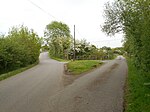Stretton-under-Fosse
Civil parishes in WarwickshireVillages in WarwickshireWarwickshire geography stubs
Stretton-under-Fosse is a village and civil parish in the English county of Warwickshire. In 2001 its population was recorded as 185, increasing to 234 at the 2011 Census. The village contains a number of old cottages along its main street. Just outside Stretton is an old manor house, Newbold Revel, which is currently used as a training college for prison officers. Nearby is the Oxford Canal and a canal arm leading to Stretton Wharf. Stretton means "settlement on a Roman road" (from the Old English stræt and tun). In this case the road is Fosse Way.
Excerpt from the Wikipedia article Stretton-under-Fosse (License: CC BY-SA 3.0, Authors).Stretton-under-Fosse
Main Street,
Geographical coordinates (GPS) Address Nearby Places Show on map
Geographical coordinates (GPS)
| Latitude | Longitude |
|---|---|
| N 52.42783 ° | E -1.33815 ° |
Address
Main Street
Main Street
CV23 0PX
England, United Kingdom
Open on Google Maps









